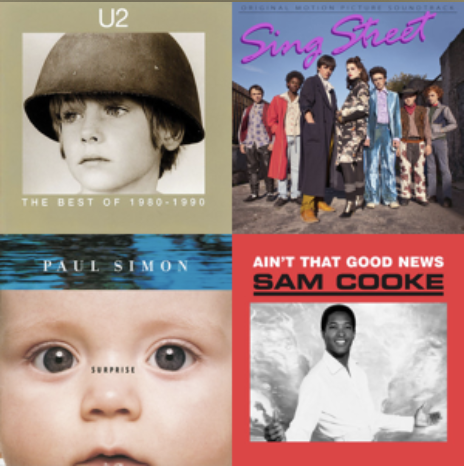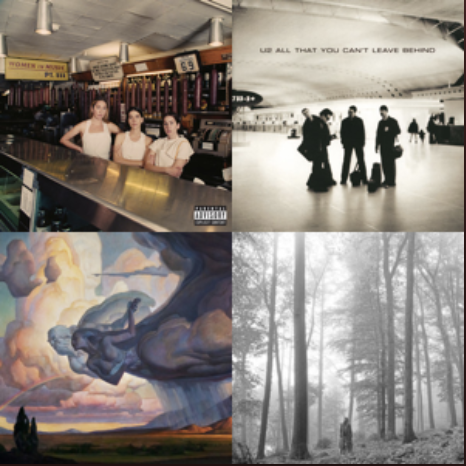
Singer/songwriter Sandra McCracken has crafted beautiful, thought-provoking songs for seven albums now. Musically, she’s well-known for folk-rock, pop, and Americana sensibilities; lyrically, she frames attentive, abstract ideas. On her latest album, Red Balloon, she marries her trademarks with innovative layers of electronic sound creating a work of ethereal spirit, as in the first song, “Guardian” – an organ note pressed down, sounding like a hovering over still waters. One by one, electric piano, guitar, and a drum loop form music out of a singular resonance. Sandra’s soulful, honest vocal sings with consolation, an empathetic melody:
Hold on to me
when you are so tired,
when you are so tired
of holding up your hand.
Steady on your feet
I will not let you stumble,
will not let you stumble,
I will not fall asleep.
When you go out,
when you come home,
like a hedge,
like a shield,
I’ll be your guardian.
And so her lyrics remain conceptual and run deep – yet in a lovely paradox, words from Red Balloon relate more directly to each listener. The genesis of these changes to unfiltered production and intimacy began on a duet EP, Ampersand, created with her husband (fellow songwriter Derek Webb) in their upstairs studio. The freedom of making music on the home front worked very well – so much so that they continued the process on Red Balloon, inviting their friend from the neighborhood, Cason Cooley, to join in the musical and production efforts. In this familiar setting, spontaneous captures reveal the most genuine, uninhibited performances from McCracken to date.
• You can hear songs from Red Balloon at the sampler on NoiseTrade.
‚Ä¢ To buy Red Balloon, visit Sandra McCracken’s web store, iTunes, or Amazon mp3.
• Sandra is currently on national tour with Derek Webb, Sara Groves, Charlie Peacock, and Brandon Heath for the Art Music Justice tour.
Another recurrent idea on Red Balloon is motherhood (she gave birth to a son last year), yet these maternal concepts are blanketed with symbolism – not only to women with children, but to anyone seeking protection, care, and guidance. She points to where such solace can be found, and writes essential songs for our culture – a society in which marriages shatter every day and motherhood is diminished from its vital role in shaping humanity, in which we neglect to truly care for our neighbor, and where the bone-weary tread desolate terrain with almost every step. Sandra McCracken’s songs remind us of the fundamentals of goodness, the hopeful truth of restoration, and our part in this healing.
Red Balloon is a quintessential record – in my top 10 – so I was excited for the chance to pick this musician’s brain. With a cup of coffee in hand, I settled into my own upstairs “studio” to talk with Sandra, a very kind, good soul.
Well, I love the new album. It’s pretty much all I’ve been listening to lately.
Thank you so much.
I hear similarities in production on Ampersand and Red Balloon. Is that due to a change in how you and Derek worked together on both projects?
Yeah, we kind of hit a stride in the way we approached Ampersand. We were thinking about this next record and it definitely seemed like one spilled right into the other. Some of it was intentional because that duet album was such a carefree experience of being able to make the record sound like anything we wanted. There were no constraints, no labels; it was such an open, creative experience. We wanted to set the tone like that for Red Balloon as well, and there was even a little overlap in the recording process, so it’s interesting that you noticed.
Did any musicians inspire you to be more experimental with elements of electronica, layers, and so on?
There were a few things we were listening to. The last couple years, I loved the orchestration of Sufjan Stevens and the way he experiments with sound. His records really keep me coming back. There’s so much to listen to, and it sounds so human. At the same time, it’s not just polished ear candy. He takes a different approach entirely; it is orchestration, but it’s not over-thought – it’s still very spirited. And Derek was listening to a lot of Gnarls Barkley. He’s working on another project that will have lots of electronica elements – even like the Trent Reznor record, The Slip. He’s been listening to a lot of things that are heavier in terms of programming.
For a long time I was resistant to that idea because I wanted my records to be timeless. So, after making a handful of records, I started to feel a little liberty. I shouldn’t hold myself back or restrain the sound of the record just because something is modern, current, or hip. That sounds backward, because a lot of people pursue that cutting-edge sound quality. I’ve almost resisted it because I didn’t want the records to sound dated when you look back. So this album joined two philosophies: maintain a timeless, soulful performance, but also use the newest tools from the moment. In this case, we used a program called Stylist to build and work with the loops. It was part of the writing in these songs, almost like another musician – having this other technological part involved, like you’re dealing with some other inanimate being.
Why does the Red Balloon packaging include two discs with five songs each? Is it a thematic layout?
There was some talk along the way of making two EPs, partly because making and getting feedback on Ampersand was such a good experience. There are six songs – it’s like a full meal, but it’s not so long that you lose the last four songs, and end up only knowing the first half of the record. People listen to music differently than they did even ten years ago as we move from a CD format to the iPod. I wanted to make two sides with smaller, digestible bits of art, though they’re definitely made to go together. It’s a different listening experience, where you can drive from your house to a lunch appointment with one record, and one on the way back.
I keep linking two songs – “Saturn’s Fields” and “The High Countries.” They’re both at the end of a disc; both describe embarking on a train or bus to unknown, otherworldly scenery. Is there a connection?
They do have similar themes, but they were written at very different times. “The High Countries” was written some years ago, inspired by C.S. Lewis’ book The Great Divorce. The images are pulled out of Lewis’ imagination. He talks about a purgatorial state, as if you had a moment to look back over your life and think about the decision of whether or not to have faith. It’s a fascinating, very imaginative story about the characters and the things they held onto in their life – what they were unwilling to part with in order to embrace faith.
“Saturn’s Fields” is a personal reflection of stepping off a ledge into the unknown of a new place in your life. Preparing for some unknown change is like planning to move to another planet – you have no idea how to do that. You just have to go and get on that train and find yourself in a new place. So, the songs are very different in terms of inspiration, but they both have almost a fictional setting that helps you go to that emotional place.
Fiction often does that, just thinking out loud.
It’s a useful tool for sure. Fiction can be a remarkable place to tell real truth because it’s so disarming. It takes you out of the confines of reality. You stop thinking, “Oh, that could never happen,” and start exploring the possibilities on many levels.
Does C.S. Lewis have a big impact on your art in general?
I have read a number of his writings over the years, so I’d say so, but there are other books, too, like The Time Traveler’s Wife, The Shack, A Wrinkle in Time, Many Waters, and Spiderman graphic novels. I used to feel like I should only read things that were concrete and easy to find your way into, but I’ve really enjoyed fiction a lot more over the last few years, some of Lewis’ as well. As an artist, I’m scolding myself for having missed that because fiction is such an inspiring medium for me as a songwriter.
I read a few biographies and autobiographies the past couple years, too, like Cash by Johnny Cash this last summer. I just love hearing people’s stories – their real stories as well as fiction, things I had overlooked and came back to, books I should have read and missed somehow. Maybe it’s because we had a baby and I’ve had little blocks of time where I could digest more reading. It sounds funny because you would think you have less time, but you have a different kind of time.
Why did you choose to revisit “The High Countries” after writing it for Caedmon’s Call [Back Home]?
I had been playing it live and people asked for it at shows. It has such an ethereal quality that seemed to really match some of the material on this record; the story it tells. It seemed to fit and it never really had before. When I wrote it I didn’t plan to record it because I imagined Danielle [Young] singing; it was very much tailored for her. I wanted to see if we could come up with something fitting for this album and also would feel like I could try it on myself. I think it was a good match.
Definitely. It is interesting how it’s the same song, yet both versions are very different and match both of your voices so well.
Thank you.
I gathered “Storehouse” is about your son – it’s a fun, inspiring look into motherhood; such a great song. How has motherhood affected your creative process?
I think I expected that my creativity would slow or come to a screeching halt. That is true in the very beginning – you’re kind of in a fog right before and for a couple months afterwards. That transition is so intense and takes your whole being to make that change. But soon after, I started journaling and writing down thoughts that didn’t make a lot of sense at the time and some of these songs came out of that. As we got into the groove, I did have large blocks of time where I was at home and felt really creative.
Motherhood is such a creative work, and it definitely begets more creativity. It’s like your creative muscle gets started and flexes in different areas. I was relieved, and it helped me feel like a whole person – that I was still able to create music and songs and have things to say. Some of this was about that experience, but some of it was other reflections on what was happening around me and within me, not related to having a baby. It was important to me to try to draw from all of it, from the whole experience, not just one narrow view of it. That was a goal in writing this batch of songs. I wanted to personally reflect on the change that had been going on, but also be accessible to people that didn’t go through this specific year that I did. Maybe that’s a good ideal to maintain as an artist because you want to connect and you also want to be vulnerable. You have to have both sides.
The conversation with Sandra McCracken will be continued in the October 17 edition.
For Further Listening
– Check out her discography which can be purchased on her web store or iTunes.
– Also on iTunes, you’ll find Sandra’s songs from the Caedmon’s Call albums In the Company of Angels, Back Home, and Overdressed, and the song “Ten Thousand Angels” (featuring Derek Webb) which aired on an episode of Grey’s Anatomy.
– Check out Sandra’s work on the Indelible Grace records.



